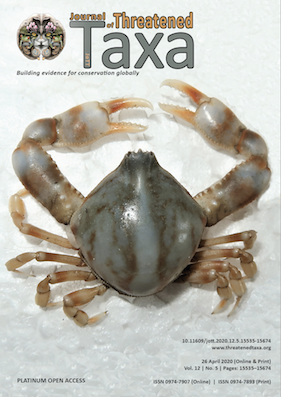Habitat structure determines the abundance of the Endangered Sharpe’s Longclaw Macronyx sharpei (Aves: Passeriformes: Motacillidae) at Timau montane grasslands in central Kenya
Main Article Content
Abstract
Understanding the habitat selection and structure of a species is critical for developing evidence-centered conservation actions. Sharpe’s Longclaw Macronyx sharpei, a passerine bird endemic to Kenya, is threatened by reductions in habitat size and quality that have left it inhabiting a small and highly fragmented range. From January to June 2016 we investigated the abundance and density of Sharpe’s Longclaw in Marania farm located in Meru county in the northern sector of Mt. Kenya, where no previous study had been done. Population abundance and density were determined using the flush and count method. We observed that these birds were exclusively found in grasslands, being most abundant in habitats of short grass with tussocks, and less so in areas with tall grass. This habitat specificity indicates a key requirement for survival of Sharpe’s Longclaw populations in this area. We recommend surveys in and around Marania farm to determine the distribution of suitable habitats for this species, and that the farm be designated an Important Bird Area. Further studies should also focus on determining the intensity of grazing that is compatible with conservation of Sharpe’s Longclaw populations.
Article Details
Authors own the copyright to the articles published in JoTT. This is indicated explicitly in each publication. The authors grant permission to the publisher Wildlife Information Liaison Development (WILD) Society to publish the article in the Journal of Threatened Taxa. The authors recognize WILD as the original publisher, and to sell hard copies of the Journal and article to any buyer. JoTT is registered under the Creative Commons Attribution 4.0 International License (CC BY), which allows authors to retain copyright ownership. Under this license the authors allow anyone to download, cite, use the data, modify, reprint, copy and distribute provided the authors and source of publication are credited through appropriate citations (e.g., Son et al. (2016). Bats (Mammalia: Chiroptera) of the southeastern Truong Son Mountains, Quang Ngai Province, Vietnam. Journal of Threatened Taxa 8(7): 8953–8969. https://doi.org/10.11609/jott.2785.8.7.8953-8969). Users of the data do not require specific permission from the authors or the publisher.
References
Bennun, L.A. & P. Njoroge (1999). Important Bird Areas in Kenya. Nature Kenya, East Africa Natural History Society. Nairobi, Kenya, 199pp. DOI: https://doi.org/10.5962/bhl.title.87589
Benton, T.G., J.A. Vickery & J.D. Wilson (2003). Farmland biodiversity: is habitat heterogeneity the key? Trends in Ecology & Evolution 18(4): 182–188. https://doi.org/10.1016/S0169-5347(03)00011-9 DOI: https://doi.org/10.1016/S0169-5347(03)00011-9
BirdLife International (2018). Species factsheet: Macronyx sharpei. Downloaded from http://www.birdlife.org on 27 May 2018.
Borghesio, L., M. Muchai, K. Ndang’ang’a & P. Njoroge (2013). Is Sharpe’s Longclaw Macronyx sharpei a fire-dependent species in Kenya’s Altimontane zone? Bulletin of Africa Bird Club 20(2): 149–155.
Fisher, R.J. & S.K. Davis (2011). Post-fledging dispersal, habitat use, and survival of Sprague’s pipits: Are planted grasslands a good substitute for native? Biological Conservation 144(1): 263–271. https://doi.org/10.1016/j.biocon.2010.08.024 DOI: https://doi.org/10.1016/j.biocon.2010.08.024
Gakuubi, M.M. & W. Wanzala (2012). A survey of plants and plant products traditionally used in livestock health management in Buuri District, Meru County, Kenya. Journal of Ethnobiology and Ethnomedicine 8(1): 39. https://doi.org/10.1186/1746-4269-8-39 DOI: https://doi.org/10.1186/1746-4269-8-39
Girma, Z., Y. Mamo, G. Mengesha, A. Verma & T. Asfaw (2017). Seasonal abundance and habitat use of bird species in and around Wondo Genet Forest, south‐central Ethiopia. Ecology and Evolution 7(10): 3397–3405. https://doi.org/10.1002/ece3.2926 DOI: https://doi.org/10.1002/ece3.2926
Kantrud, H.A. (1981). Grazing intensity effects on the breeding avifauna of North Dakota native grasslands. Canadian Field Naturalist 95(4): 404–417.
Keith, G.S., E.K. Urban & C.H. Fry (1992). The Birds of Africa, Volume 4. Academic Press, London, 608pp.
Kimani, D., W. Wamiti, K. Ndang’ang’a & J. Gitogo (2015). Field report to NABU, BirdLife International Germany on Survey of Sharpe’s Longclaw Macronyx sharpei in the northern sector of Mt. Kenya. Moorland and Timau Grasslands, Meru County, Kenya.
Knopf, F.L. & J.R. Rupert (1996). Reproduction and movements of Mountain Plovers breeding in Colorado. The Wilson Bulletin 108(1): 28–35.
Maphisa, D.H., H. Smit-Robinson, L.G Underhill & R. Altwegg (2017). Management factors affecting densities of common grassland birds of high elevation grasslands of eastern South Africa: Ingula as a case study. Avian Research 8: 5. https://doi.org/10.1186/s40657-017-0063-8 DOI: https://doi.org/10.1186/s40657-017-0063-8
McCain, C.M. (2009). Global analysis of bird elevation diversity. Global Ecology and Biogeography 18: 346–360. https://doi.org/10.1111/j.1466-8238.2008.00443.x DOI: https://doi.org/10.1111/j.1466-8238.2008.00443.x
McDonald, L. (2017). The influence of patch size, landscape composition, and edge proximity on songbird densities and species richness in the northern tall-grass prairie. MSc Thesis. Department of Environment and Geography, University of Manitoba, Winnipeg, Manitoba, xiii+110pp.
Muchai, M. (1998). Some aspects of the conservation biology of Sharpe’s Longclaw (Macronyx sharpei, Jackson 1904) - a Kenya grassland endemic bird. MSc Thesis. Department of Zoology, Moi University, Eldoret, Kenya, xiv+111pp.
Muchai, M., L. Lens & L. Bennun (2002). Habitat selection and conservation of Sharpe’s Longclaw (Macronyx sharpei), a threatened Kenyan grassland endemic. Biological Conservation 105(3): 271–277.
Mwangi, J.M., G. Wahungu & M. Muchai (2012). Effects of habitat fragmentation on movement, dispersal, population and nesting success of Sharpe’s (Macronyx sharpei Jackson, 1904) in Kinangop Plateau, Kenya. MSc Thesis. Department of Wildlife Management, Moi University, Kenya, xii+73pp.
Ndang’ang’a, P.K., M.A. du Plessis, P.G. Ryan & L.A. Bennun (2002). Grassland decline in Kinangop Plateau, Kenya: implications for conservation of Sharpe’s Longclaw (Macronyx sharpei). Biological Conservation 107: 341–350.
Ogada, D.L., M.E. Gadd, R.S. Ostfeld, T.P. Young & F. Keesing (2008). Impacts of large herbivorous mammals on bird diversity and abundance in an African savanna. Oecologia 156(2): 387–97. https://doi.org/10.1007/s00442-008-0994-1 DOI: https://doi.org/10.1007/s00442-008-0994-1
Sliwinski, M.S. & N. Koper (2015). Managing mixed-grass prairies for songbirds using variable cattle stocking rates. Rangeland Ecology and Management 68(6): 470–475. https://doi.org/10.1016/j.rama.2015.07.010 DOI: https://doi.org/10.1016/j.rama.2015.07.010
Wamiti, W., P. Malaki & A. Mwangi (2008). Birds of Conservation Concern Upgrades Lake Ol’ Bolossat Status to Kenya’s 61st Important Bird Area. Paper presented at the 12th Pan-African Ornithological Congress, Goudin Spa Conference Centre, Cape Town, South Africa, 7–12 September 2008.

